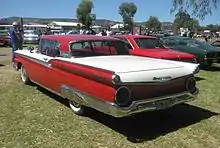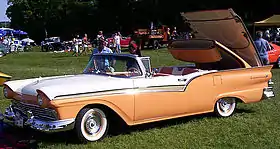- See also Ford Crestline Skyliner for the 1954 Ford and Ford Fairlane Crown Victoria Skyliner for the 1955–1956 Ford Fairlane Crown Victoria, both with an acrylic glass roof panel.
| Ford Fairlane 500 Skyliner | |
|---|---|
 | |
| Overview | |
| Manufacturer | Ford |
| Also called | Ford Galaxie (500) Skyliner Ford Retractable[1] |
| Production | 1957–1959 48,394 produced |
| Body and chassis | |
| Class | Full-size car |
| Body style | 2-door retractable hardtop |
| Dimensions | |
| Wheelbase | 118 in (2997.2 mm) |
| Length | 210.8 in (5354.32 mm) |
| Height | 56.3 in (1430.02 mm) |
| Chronology | |
| Predecessor | Ford Fairlane Crown Victoria Skyliner |
The Ford Fairlane 500 Skyliner is a two-door full-size retractable hardtop convertible, manufactured and marketed by Ford Motor Company for model years 1957–1959. However, early into the 1959 model year, its name was expanded to Fairlane 500 Galaxie Skyliner.[2] The retracting roof system was marketed as the Hide-Away Hardtop, and was exclusively sold on this Ford-branded model, for three model years.
Ford's 1957 Skyliner was the world's first retracting hardtop convertible to be truly mass-produced by a car company from the factory, coming close to 50,000 sales. Earlier, French car-maker Peugeot had offered several such models in the 1930s, with the help of a coachbuilding company, which sold only in very limited numbers. It also marked the first time the hard roof featured a folding (front) section, to retract and fit inside the car's trunk.
Naming and marketing
Ford first used the Skyliner name in 1954, on the two-door hardtop Ford Crestline Skyliner, and on the 1955 and 1956 Fairlane Crown Victoria Skyliner coupes. These models feature a clear acrylic glass roof panel over the front seats.
For 1957–1959, Ford brought the Fairlane 500 Skyliner, featuring a powered, retracting and folding hardtop roof. For the model year 1959, the name was changed to Ford Fairlane 500 Galaxie Skyliner, shortly after production began (also illustrated as such in the brochure but described only as "Galaxy" in the related text). The retractable roof mechanism, marketed as the "Hide-Away Hardtop",[2] was unique to Ford-branded products, and was not offered on any Continental, Lincoln, Mercury, or Edsel branded vehicles.
Design
Offering the Skyliner Retractable in Ford's Fairlane (500) range, Ford was only the second car-maker in history to produce retractable hardtops in series (following the 1930s Georges Paulin designed Peugeot 401, 402, and 601 "Eclipse Decapotable" models, converted by Carrosserie Pourtout coachbuilders); and the world's first to reach four- and five-digit mass-production numbers. Ford's design was also the first series produced coupé convertible featuring a roof using two segments, and during its production run, the Skyliner was the only hardtop convertible available.[3]
The Skyliner's retractable top operated via a complex mechanism that folded the front of the roof and retracted it under the rear decklid. Instead of the typical hydraulic mechanisms, the Skyliner top used seven reversible electric motors (six for 1959 models [4]), four lift jacks, a series of relays, ten limit switches, ten solenoids, four locking mechanisms for the roof and two locking mechanisms for the trunk lid,[5] and 610 ft (185.9 m) of wiring.[6] The top largely consumed available trunk space, limiting the car's sales, though the mechanism operated reliably.[5][7][8] Production totaled 20,766 units in 1957, declining to 14,713 in 1958 and to 12,915 in 1959.[8] An electric clock was standard.[9] Fuel consumption was around 14 mpg‑US (17 L/100 km; 17 mpg‑imp) overall.[5] The fuel tank was placed vertically in back of the rear seat, offering increased safety in a rear collision.[7]
The wheelbase of the Skyliner was 118 in (3,000 mm) and the overall length was 210.8 in (5,350 mm).[6][10]

During the 1959 model year, Ford added the new top-of-the-line Galaxie series to its full-size lineup, and the Skyliner model became part of that series.[9][11] Although the 1959 Galaxie was designated as a separate series,[11] Galaxies carried both “Fairlane 500” and “Galaxie” badging, on the rear and sides respectively.[12] It came with the standard 292 cu in (4.8 L) 2-barrel 200 hp (149 kW; 203 PS) V8 engine.[9]
Requiring a shorter roof and longer trunk, the retractable roof concept was originally intended for Ford's Continental brand.[13][14] The mechanism's complexity would have required an even more expensive marketing position for a Continental, and when Ford projected losses for this route, the company re-conceived the model and restyled it from the waist down — projecting it would attract more buyers under the Ford brand.[15] Though prescient, the concept ultimately attracted more attention than sales; it was expensive, thought to be unreliable, and consumed almost all trunk space when retracted. The listed retail price was US$2,942 ($26,632 in 2022 dollars [16]) with several items available optionally like power windows, power-adjustable front seat, power steering, power brakes, heater and windshield defroster.[9]
Although the actual mechanicals differed, the Skyliner's retractable roof design was later adopted for the Lincoln Continental fabric convertibles of 1961–67.
Engines and transmissions
The following engines, all V8s, were available on the Fairlane 500 Skyliner.
| Size [8] | Horsepower [8] | Model Years [8] |
| 272 cu in (4.5 L) | 190 hp (140 kW) | 1957 |
| 292 cu in (4.8 L) | 200 hp (150 kW) 205 hp (153 kW) 212 hp (158 kW) |
1957, 1958 & 1959 |
| 312 cu in (5.1 L) | 245 hp (183 kW) | 1957 |
| 332 cu in (5.4 L) | 225 hp (168 kW) 240 hp (180 kW) 265 hp (198 kW) |
1958 & 1959 |
| 352 cu in (5.8 L) | 300 hp (220 kW) | 1958 & 1959 |
Two manual transmissions, a three-speed and three-speed overdrive, and a three-speed Ford-O-Matic automatic transmission. Starting in 1958, Cruise-O-Matic was added, which provided a second "drive" range ("D2"), allowing for an intermediate gear start.[6]
 1957 Ford Fairlane 500 Skyliner
1957 Ford Fairlane 500 Skyliner 1958 Ford Fairlane 500 Skyliner
1958 Ford Fairlane 500 Skyliner 1959 Ford Fairlane 500 Skyliner
1959 Ford Fairlane 500 Skyliner
Notes
- ↑ "International Ford Retractable Club". www.skyliner.org. Retrieved 28 October 2019.
- 1 2 "1957 Ford Skyliner brochure". oldcarbrochures.com. Retrieved 10 December 2016.
- ↑ John Gunnell, The Standard Catalog of American Cars 1945 to 1975, Revised 4th Edition, page 397
- ↑ Ford Motor Company, 1959 Ford Car Shop Manual, 3rd Edition, page 502
- 1 2 3 Willson, Quentin (1995). The Ultimate Classic Car Book. DK Publishing. ISBN 0-7894-0159-2.
- 1 2 3 Owner's plaque, 50th Anniversary Draggins car show, shot 3 April 2010.
- 1 2 Langworth, Richard (1982). Great Cars from Ford. ISBN 0-89009-537-X.
- 1 2 3 4 5 "1957–1959 Ford Fairlane 500 Skyliner". Auto.howstuffworks.com. 2007-07-20. Retrieved 2011-11-20.
- 1 2 3 4 Flory, Jr., J. "Kelly" (2008). American Cars, 1946–1959 Every Model Every Year. McFarland. ISBN 978-0-7864-3229-5.
- ↑ "1957 Ford Skyliner brochure". oldcarbrochures.com. Retrieved 2011-11-20.
- 1 2 John Gunnell, The Standard Catalog of American Cars 1945 to 1975, Revised 4th Edition, page 402
- ↑ "1959 Ford brochure". oldcarbrochures.com. Retrieved 14 January 2011.
- ↑ "Lot 115 - 1957 Ford Fairlane 500 Skyliner Retractable Hardtop". Rmsothebys.com. 2014-11-15. Retrieved 2016-01-23.
- ↑ Bonsall, Thomas E. (2003). The Lincoln Story: The Postwar Years. Stanford University Press. p. 56. ISBN 9780804749411. Retrieved 2016-01-23.
- ↑ Aaron Severson (26 April 2009). "Raising the Roof: The Ford Skyliner 'Retrac'". Ate Up With Motor. Retrieved 2016-12-09.
- ↑ 1634–1699: McCusker, J. J. (1997). How Much Is That in Real Money? A Historical Price Index for Use as a Deflator of Money Values in the Economy of the United States: Addenda et Corrigenda (PDF). American Antiquarian Society. 1700–1799: McCusker, J. J. (1992). How Much Is That in Real Money? A Historical Price Index for Use as a Deflator of Money Values in the Economy of the United States (PDF). American Antiquarian Society. 1800–present: Federal Reserve Bank of Minneapolis. "Consumer Price Index (estimate) 1800–". Retrieved May 28, 2023.
Bibliography
- Holmes, Mark (2007). Ultimate Convertibles: Roofless Beauty. London: Kandour. pp. 74–75. ISBN 978-1-905741-62-5.